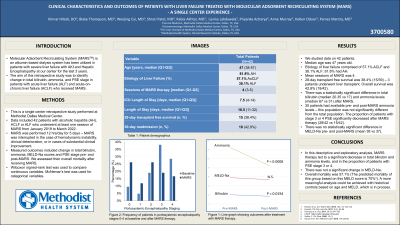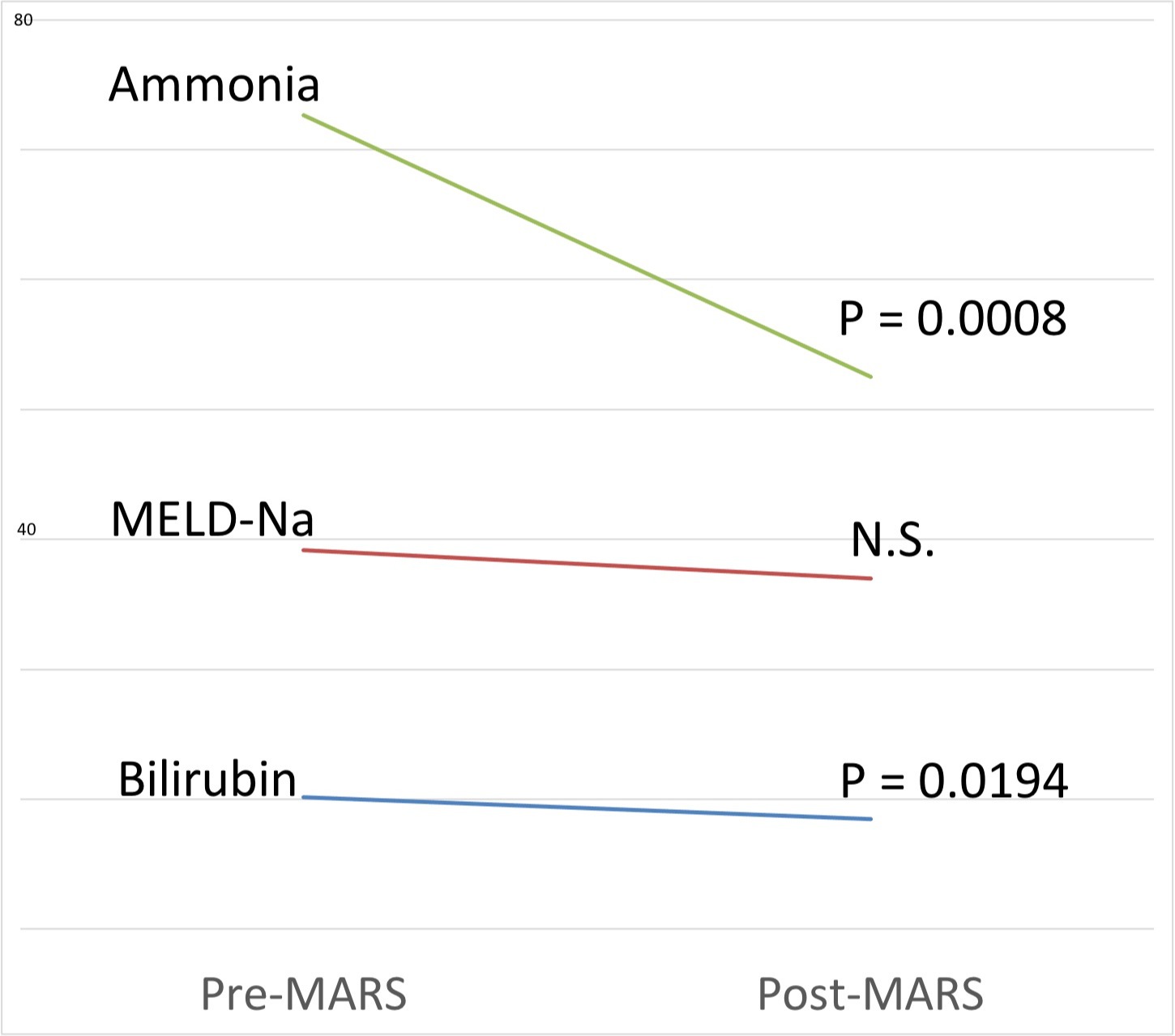Back


Poster Session B - Monday Morning
Category: Liver
B0496 - Clinical Characteristics and Outcomes of Patients With Liver Failure Treated With Molecular Adsorbent Recirculating System (MARS): A Single Center Experience
Monday, October 24, 2022
10:00 AM – 12:00 PM ET
Location: Crown Ballroom

Has Audio

Kinnari Modi, MD
Methodist Dallas Medical Center
Dallas, TX
Presenting Author(s)
Kinnari Modi, MD1, Blake Thompson, MD1, Wenjing Cai, MD1, Shruti Patel, MD1, Rabia Akhtar, MD1, Lavina Lakdawala, BS1, Priyanka Acharya, MPH, MSc2, Anne Murray, BS1, Hellen Oduor, BSN1, Parvez Mantry, MD1
1Methodist Dallas Medical Center, Dallas, TX; 2Methodist Health System Clinical Research Institute, Dallas, TX
Introduction: Molecular Adsorbent Recirculating System (MARS) is an albumin-based dialysis system has been utilized in patients with severe liver failure with AKI and Hepatic Encephalopathy at our center for the last 2-3 years. The aim of this retrospective study was to identify change in total bilirubin, ammonia, and PSE stage in patients with acute liver failure (ALF) and acute-on-chronic liver failure (ACLF) who received MARS.
Methods: This is a single center retrospective study performed at Methodist Dallas Medical Center. Data included 42 patients with alcoholic hepatitis (AH), ACLF or ALF who underwent at least one session of MARS from January 2019 to March 2022. MARS was performed 12 hrs/day for 5 days – MARS was interrupted in the case of hemodynamic instability, clinical deterioration, or in cases of substantial clinical improvement. Measured outcomes included change in total bilirubin, ammonia, MELD-Na scores and PSE stage pre- and post-MARS. We assessed their overall mortality after receiving MARS. Wilcoxon signed-rank test was used to compare continuous variables. McNemar’s test was used for categorical variables.
Results: We studied data on 42 patients. Median age was 47 years old. Etiology of liver failure comprised of 57.1% ACLF and 38.1% ALF; 81.8% had AH. Mean sessions of MARS was 4. 28-day transplant free survival was 38.4% (15/39) – 3 patients underwent liver transplant. Overall survival was 42.8% (18/42). There was a statistically significant difference in total bilirubin (median 20.35 vs 17) and ammonia levels (median 67 vs 31) after MARS. 30 patients had available pre- and post-MARS ammonia levels – this population was not significantly different from the total population. The proportion of patients with stage 3 or 4 PSE significantly decreased after MARS therapy (28/42 vs 15/42). There was no statistically significant difference in MELD-Na pre- and post-MARS (mean 38 vs 37).
Discussion: In this descriptive and exploratory analysis, MARS therapy led to a significant decrease in total bilirubin and ammonia levels, and in the proportion of patients with PSE stage 3 or 4. There was not a significant change in MELD-Na. Overall mortality was 61.6% (The predicted mortality of this group based on this MELD score is 70%). A more meaningful analysis could be achieved with historical controls based on age and MELD, which is in process.

Disclosures:
Kinnari Modi, MD1, Blake Thompson, MD1, Wenjing Cai, MD1, Shruti Patel, MD1, Rabia Akhtar, MD1, Lavina Lakdawala, BS1, Priyanka Acharya, MPH, MSc2, Anne Murray, BS1, Hellen Oduor, BSN1, Parvez Mantry, MD1. B0496 - Clinical Characteristics and Outcomes of Patients With Liver Failure Treated With Molecular Adsorbent Recirculating System (MARS): A Single Center Experience, ACG 2022 Annual Scientific Meeting Abstracts. Charlotte, NC: American College of Gastroenterology.
1Methodist Dallas Medical Center, Dallas, TX; 2Methodist Health System Clinical Research Institute, Dallas, TX
Introduction: Molecular Adsorbent Recirculating System (MARS) is an albumin-based dialysis system has been utilized in patients with severe liver failure with AKI and Hepatic Encephalopathy at our center for the last 2-3 years. The aim of this retrospective study was to identify change in total bilirubin, ammonia, and PSE stage in patients with acute liver failure (ALF) and acute-on-chronic liver failure (ACLF) who received MARS.
Methods: This is a single center retrospective study performed at Methodist Dallas Medical Center. Data included 42 patients with alcoholic hepatitis (AH), ACLF or ALF who underwent at least one session of MARS from January 2019 to March 2022. MARS was performed 12 hrs/day for 5 days – MARS was interrupted in the case of hemodynamic instability, clinical deterioration, or in cases of substantial clinical improvement. Measured outcomes included change in total bilirubin, ammonia, MELD-Na scores and PSE stage pre- and post-MARS. We assessed their overall mortality after receiving MARS. Wilcoxon signed-rank test was used to compare continuous variables. McNemar’s test was used for categorical variables.
Results: We studied data on 42 patients. Median age was 47 years old. Etiology of liver failure comprised of 57.1% ACLF and 38.1% ALF; 81.8% had AH. Mean sessions of MARS was 4. 28-day transplant free survival was 38.4% (15/39) – 3 patients underwent liver transplant. Overall survival was 42.8% (18/42). There was a statistically significant difference in total bilirubin (median 20.35 vs 17) and ammonia levels (median 67 vs 31) after MARS. 30 patients had available pre- and post-MARS ammonia levels – this population was not significantly different from the total population. The proportion of patients with stage 3 or 4 PSE significantly decreased after MARS therapy (28/42 vs 15/42). There was no statistically significant difference in MELD-Na pre- and post-MARS (mean 38 vs 37).
Discussion: In this descriptive and exploratory analysis, MARS therapy led to a significant decrease in total bilirubin and ammonia levels, and in the proportion of patients with PSE stage 3 or 4. There was not a significant change in MELD-Na. Overall mortality was 61.6% (The predicted mortality of this group based on this MELD score is 70%). A more meaningful analysis could be achieved with historical controls based on age and MELD, which is in process.

Figure: Figure 1: Line graph showing outcomes after treatment with MARS therapy.
Disclosures:
Kinnari Modi indicated no relevant financial relationships.
Blake Thompson indicated no relevant financial relationships.
Wenjing Cai indicated no relevant financial relationships.
Shruti Patel indicated no relevant financial relationships.
Rabia Akhtar indicated no relevant financial relationships.
Lavina Lakdawala indicated no relevant financial relationships.
Priyanka Acharya indicated no relevant financial relationships.
Anne Murray indicated no relevant financial relationships.
Hellen Oduor indicated no relevant financial relationships.
Parvez Mantry indicated no relevant financial relationships.
Kinnari Modi, MD1, Blake Thompson, MD1, Wenjing Cai, MD1, Shruti Patel, MD1, Rabia Akhtar, MD1, Lavina Lakdawala, BS1, Priyanka Acharya, MPH, MSc2, Anne Murray, BS1, Hellen Oduor, BSN1, Parvez Mantry, MD1. B0496 - Clinical Characteristics and Outcomes of Patients With Liver Failure Treated With Molecular Adsorbent Recirculating System (MARS): A Single Center Experience, ACG 2022 Annual Scientific Meeting Abstracts. Charlotte, NC: American College of Gastroenterology.
